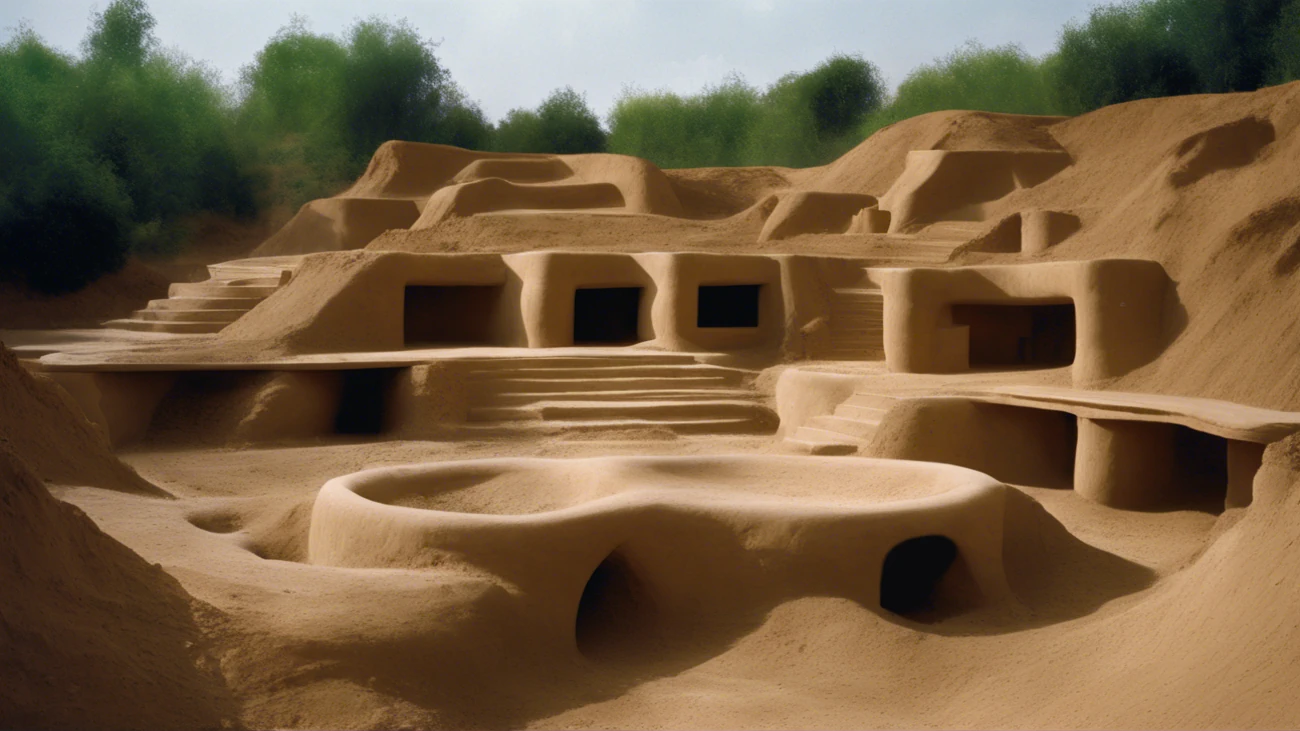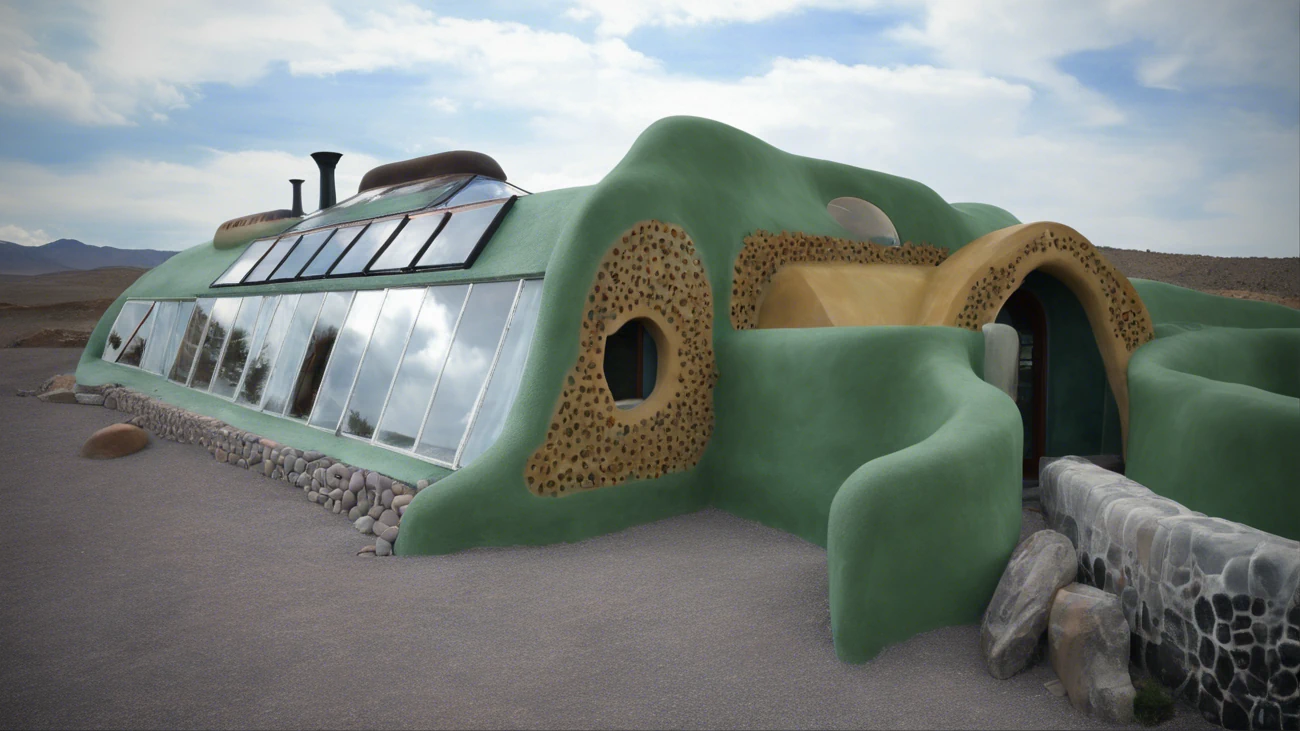Introduction
The use of earth as a building material dates back centuries, embodying a sustainable and eco-friendly approach to construction. Earth structures encompass a wide array of techniques, ranging from adobe and cob to rammed earth and compressed stabilized earth blocks, these methods harness the intrinsic properties of soil, offering not just cost-effective solutions but also low environmental impact during construction and throughout a building's lifecycle.
Soil, the fundamental component of earth structures, holds unique properties that contribute to its suitability for construction, its availability, versatility, and thermal mass characteristics make it an attractive choice for builders across diverse landscapes. Different types of soil offer distinct benefits; for instance, clay-rich soil exhibits excellent binding properties, while sandy soil can be enhanced for stability through compression techniques.
Various earth building techniques:
- Adobe: Comprising a mixture of earth, sand, and straw, adobe bricks are sun-dried, forming robust structures. This technique, prevalent in arid regions, facilitates excellent thermal regulation due to its inherent insulation properties.
- Cob: Cob construction involves mixing clay-rich soil with straw and water, forming a pliable mass that is then molded by hand into walls. Its sculptural flexibility allows for curvilinear designs and organic structures.
- Rammed earth: This method compacts damp soil layers within formworks to create dense, load-bearing walls. By layering and compressing soil, rammed earth structures boast durability and thermal stability.
- Compressed Stabilized Earth Blocks (CSEB): CSEBs are formed by compressing a mixture of soil, stabilizers like cement or lime, and water into blocks. This technique ensures uniformity, strength, and resistance to weathering, making it suitable for various architectural styles.
Advantages and disadvantages of earth structures
Advantages:
Earth structures offer a multitude of advantages that make them an attractive option for sustainable and cost-effective building solutions:
- Sustainability: Utilizing earth as a building material is inherently sustainable. Earth is abundant, renewable, and locally available in most regions, reducing the need for transporting materials over long distances. Its use minimizes the environmental impact associated with extraction, manufacturing, and transportation of conventional construction materials.
- Low Environmental impact: Earth structures have a significantly lower carbon footprint compared to resource-intensive materials like concrete or steel. They require minimal processing, thus reducing energy consumption and greenhouse gas emissions during production. Additionally, they often promote natural ventilation and reduce the need for energy-intensive heating or cooling systems, further lessening their environmental impact.
- Thermal performance: Earth's high thermal mass allows it to absorb, store, and release heat slowly. This characteristic helps maintain more stable indoor temperatures, reducing the reliance on artificial heating or cooling systems. It leads to improved energy efficiency and lower operational costs over the building's lifespan.
- Cost-Effectiveness: Earth-based construction materials are often more affordable than traditional alternatives. The abundance of soil locally reduces material procurement costs, while the simplicity of construction techniques can lower labor expenses. Additionally, earth structures tend to require fewer specialized tools or machinery for construction.
- Durability and strength: Properly designed and maintained earth structures can be remarkably durable. Techniques such as rammed earth and stabilized earth blocks create robust, load-bearing walls capable of withstanding natural elements and providing long-term stability.
- Aesthetic versatility: Earth-based construction techniques offer architectural versatility. Builders can craft a wide range of shapes, textures, and designs, allowing for unique and visually appealing structures. From the organic curves of cob structures to the clean lines of compressed earth blocks, earth construction offers diverse aesthetic possibilities.
- Local empowerment and community engagement: Earth-based construction often involves local communities in the building process. This engagement fosters skills development, empowers local labor, and encourages community involvement in sustainable construction practices. It also strengthens the resilience of communities by utilizing materials readily available within their surroundings.
- Sound insulation and fire resistance: Earth materials exhibit good sound insulation properties, providing a quieter indoor environment. Additionally, properly constructed earth walls can offer excellent fire resistance, enhancing the safety of occupants in case of fire incidents.
- Adaptability and flexibility: Earth construction techniques are adaptable to various climates and geographical regions. Builders can modify soil mixtures and construction methods to suit local conditions, allowing for the construction of resilient structures in diverse environments.
- Cultural heritage preservation: Embracing earth-based building techniques preserves traditional knowledge and cultural heritage. Many communities around the world have a long history of using earth as a building material, and incorporating these techniques in modern construction helps sustain these valuable traditions.
These advantages collectively make earth structures a compelling choice for environmentally conscious, resilient, and economically viable building solutions, contributing to sustainable development and a greener future for construction practices.
Disadvantages
While earth structures offer numerous advantages, they also come with certain limitations and challenges that need to be considered:
- Weather vulnerability: Unprotected earth structures are susceptible to erosion, particularly from heavy rain, flooding, or prolonged exposure to harsh weather conditions. Proper waterproofing, drainage systems, and protective measures are necessary to prevent damage caused by moisture.
- Code compliance and regulation: In some regions, traditional earth construction methods may not align with modern building codes and regulations. This disparity might pose challenges for gaining approval or financing for earth-based projects, leading to limitations in their widespread adoption.
- Structural limitations: Earth structures might not be suitable for buildings requiring large open spans or extremely tall structures. Design limitations exist in terms of load-bearing capacities, making them less ideal for high-rise buildings or structures with specific architectural requirements.
- Maintenance requirements: Earth structures often require regular maintenance, such as re-plastering, re-sealing, or repairing cracks. This upkeep is necessary to ensure the longevity and structural integrity of the building, especially in areas prone to seismic activity or extreme weather conditions.
- Time-Intensive construction: The construction process for earth structures can be more time-consuming compared to conventional methods. Techniques like rammed earth or cob construction require manual labor and meticulous attention to detail, potentially extending the construction timeline.
- Limited design flexibility: While earth-based construction allows for various shapes and designs, it might have limitations in achieving certain architectural aesthetics or modern building styles. Design flexibility might be constrained compared to structures built with more versatile materials like steel or glass.
- Quality control and consistency: Achieving consistent quality in earth-based construction can be challenging, especially with variations in soil composition and local materials. Maintaining uniformity in earth blocks or ensuring proper compaction in rammed earth construction requires skill and attention to detail.
- Perception and market acceptance: Despite its advantages, there might still be a perception issue surrounding earth structures, leading to limited market acceptance. Some potential buyers or investors might prefer conventional materials due to concerns about durability, resale value, or unfamiliarity with earth-based construction.
- Pest vulnerability: Certain types of earth construction, particularly adobe or cob, can be susceptible to pest infestations such as termites. Proper treatment and preventive measures are essential to mitigate these risks.
- Accessibility to skilled labor and knowledge: Earth construction techniques often rely on specialized knowledge and skilled labor. Access to trained professionals in these techniques might be limited in some regions, hindering the widespread adoption of earth-based construction.
These disadvantages exist, many of them can be mitigated through proper planning, skilled craftsmanship, innovation in construction techniques, and ongoing research and development in the field of earth-based construction materials and methods. Despite the challenges, earth structures continue to offer significant potential as sustainable and resilient building solutions.
Case Studies and Contemporary Applications
Across the globe, innovative architects and builders are incorporating earth-based construction into modern designs:
Superadobe and hyperadobe in Iran:
- Background: Superadobe and hyperadobe are construction techniques developed by architect Nader Khalili, emphasizing the use of sandbags filled with earth and stabilized with barbed wire as building components. These methods gained prominence for their earthquake-resistant properties and affordability.
- Application in Iran: In Iran, particularly in areas prone to seismic activity, superadobe and hyperadobe techniques have been employed to construct resilient and cost-effective housing. The curved and domed structures built using these techniques offer excellent structural integrity, making them suitable for earthquake-prone regions.
The Nubian Vault in West Africa:
- Background: The Nubian Vault technique draws from ancient Egyptian building methods, using mud bricks in a vaulted roof system without wood or steel reinforcement. It relies on locally available materials and traditional construction techniques.
- Application in West Africa: In countries like Mali, Burkina Faso, and Senegal, the Nubian Vault technique has been revitalized to provide sustainable and affordable housing solutions. Local communities are trained in these methods, empowering them to construct their own homes using earth-based materials. These structures offer thermal comfort and structural stability while preserving cultural heritage.
The Earthship concept:
- Background: Earthships, pioneered by architect Michael Reynolds, are self-sustaining, off-grid homes constructed using recycled materials and earth-based construction techniques. These homes are designed to be environmentally friendly and energy-efficient.
- Application worldwide: Earthships have been built in various locations worldwide, including the United States, Europe, and other continents. These homes utilize recycled tires packed with earth to form walls, incorporating passive solar design, rainwater harvesting, and renewable energy systems for a fully sustainable living environment.
The Great wall of WA, Australia:
- Background: The Great Wall of WA project showcases the use of rammed earth construction techniques in a contemporary architectural context. Rammed earth involves compressing layers of damp earth within formworks to create solid walls.
- Application in Australia: Located in Western Australia, this project features a luxurious residence constructed using rammed earth techniques. The walls, made from locally sourced earth, provide both thermal mass and aesthetic appeal. The project highlights the versatility and elegance of earth-based materials in modern architecture.
These case studies demonstrate the diverse applications of earth-based construction techniques in different geographical regions, showcasing their adaptability, sustainability, and architectural potential. From seismic-resistant housing in Iran to sustainable, off-grid homes globally, these projects highlight the versatility and efficacy of earth-based materials in contemporary building design.
Earth structures represent an age-old yet increasingly relevant approach to sustainable building practices. With their inherent eco-friendliness, thermal efficiency, and architectural versatility, these techniques continue to gain traction in contemporary construction. Embracing earth as a primary building material not only honors tradition but also aligns with the imperative to create environmentally conscious and resilient structures for the future.
We will address these topics in more detail on this website, I hope you like it!
Are you still interested in this topic?
A good idea is to continue here:



